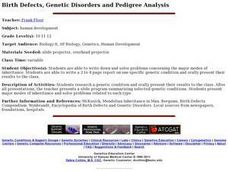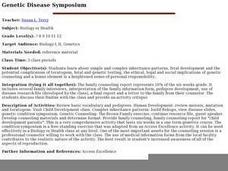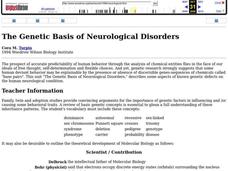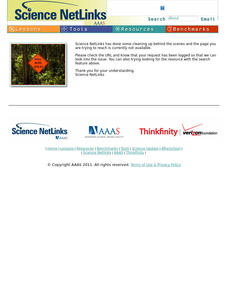Curated OER
The Human Genotype
Six different chromosome activites introduce biology aces to heredity, chromosomal abnormalities, sex-linked traits, and the human genome. The hands-on activites are fairly simple for the teacher to prepare and will prove to be both...
Curated OER
Take Home Lab: What Are Some Traits in Your Family?
Young scholars use this following the study of pedigree designs and human genetics. Four pedigree designs are prepared of your (student's) family's genetics. They construct the pedigree representing two, three, or four generations.
Curated OER
Family Traits
Young scholars investigate the study of pedigree designs and human genetics. They construct the pedigree representing two, three, or four generations. They investigate their family members' traits for ear lobe attachment, tongue...
Personal Genetics Education Project
Scientific Themes in Personal Genetics
Humans can be tested for the presence of the BRCA gene, whose presence is an indicator that they have a greater chance of acquiring breast cancer than someone without the gene. Viewers have an opportunity to explore how genes and...
Curated OER
The Electrophoresis of Human Hemoglobin
Students are presented with a scenario that requires them to electrophoreses human hemoglobin samples in order to confirm a diagnosis of sickle cell anemia and/or to determine whether individuals in the scenario are carriers of the...
Curated OER
The Value of Genetic History
Students research and assemble their own pedigrees using star patterns for each family member and coloring in various dominant traits. They arrange these patterns on long strips of paper making large, colorful family pedigrees.
Curated OER
How Does a Pedigree Help Us to Trace a Trait That is Inherited?
Students analyze genetic patterns. In this pedigree lesson, students determine dominant or recessive inheritance. They construct a human pedigree from genetic information.
Curated OER
Birth Defects, Genetic Disorders and Pedigree Analysis
Students write down and solve problems concerning the major modes of inheritance. They research a genetic condition and orally present their results to the class.
Curated OER
Genetic Disease Symposium
Students research simple and complex inheritance patterns, fetal development and the potential complications of teratogens, fetal and genetic testing, and the ethical, legal, and social implications of genetic counseling.
Curated OER
Geneticist for a Day
Students discuss and compose a document discussing the transmission of the Huntington's gene- dominant or recessive, sex linked, etc. Additionally, they ought to consider Dr. Wexler's own odds for contracting the disease.
Curated OER
Simulated Genetic Counseling Session
Students, in groups, prepare a family history for a family with a genetic condition. They simulate a genetic counseling session and listen to a guest lecture by a genetic counselor.
Curated OER
The Value of Genetic History
Learners explore their genetic background. They assemble their own pedigrees using star patterns for each family member and identifying various dominant traits. Predictions are made for future offspring.
Curated OER
The Genetic Basis of Neurological Disorders
Students explore neurological disorders. They examine the presence and absence of discernible genes. Students describe neruological diseases and draw faces of affected persons. They play a human neurology disorders learning game.
Curated OER
Gene Puzzles
Students explain that in sexually reproducing organisms, such as humans, typically half of the genes come from each parent. They examine a fictional pedigree and determine which gene is responsible for a given trait.
National Center for Case Study Teaching in Science
In Sickness and in Health
Based on family history, how likely is it that a couple's children will have a recessive disease? In an in-depth, but easy-to-follow case study, future geneticists learn the story of Greg and Olga, who are hoping to have children, but...
Curated OER
All in the Family: Calculating Cousins
Students view pictures of distant "cousins" to humans. They place them in order by their distance from humans. Students receive a packet of six pages featuring graphics and a cousins summary page. They work in groups to complete 5 cousin...
Curated OER
Biology Honors Final Project
Tenth graders work on a project about cellular biology and genetics. In this biology lesson, 10th graders research about the assigned human body system and genetic disorders that affect it. They create a multimedia presentation and...
Curated OER
The Genetic Basis of Neurological Disorders
Students describe some aspects of known genetic defects on the human neurological condition. They participate in a variety of exercises including drawings, games, and analogies.
Curated OER
The Electrophoresis of Human Hemoglobin
High schoolers analyze different types of hemoglobin. They use the technique of agarose gel electrophoresis to separate human hemoglobin molecules according to their electrical charge, size, and/or shape. Students relate the migration...
Curated OER
Gene Puzzles
Students come to understand that in sexually reproducing organisms, such as humans, typically half of the genes come from each parent.
Students examine a fictional pedigree and determine which gene is responsible for a given trait. The...
Curated OER
Last Flight of Bomber 31
Students act as forensic scientists to help solve a long-standing missing persons case. They study nuclear DNA and mtDNA.
Curated OER
Where Are the Dinosaurs?
Students explore the concept of extinction by studying dinosaurs. For this dinosaur lesson, students distinguish between extinct creatures and those that still exist.























